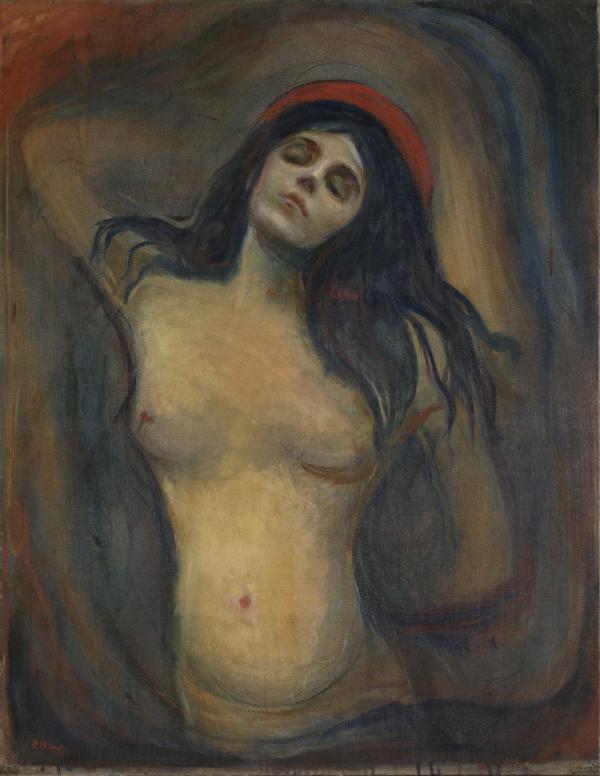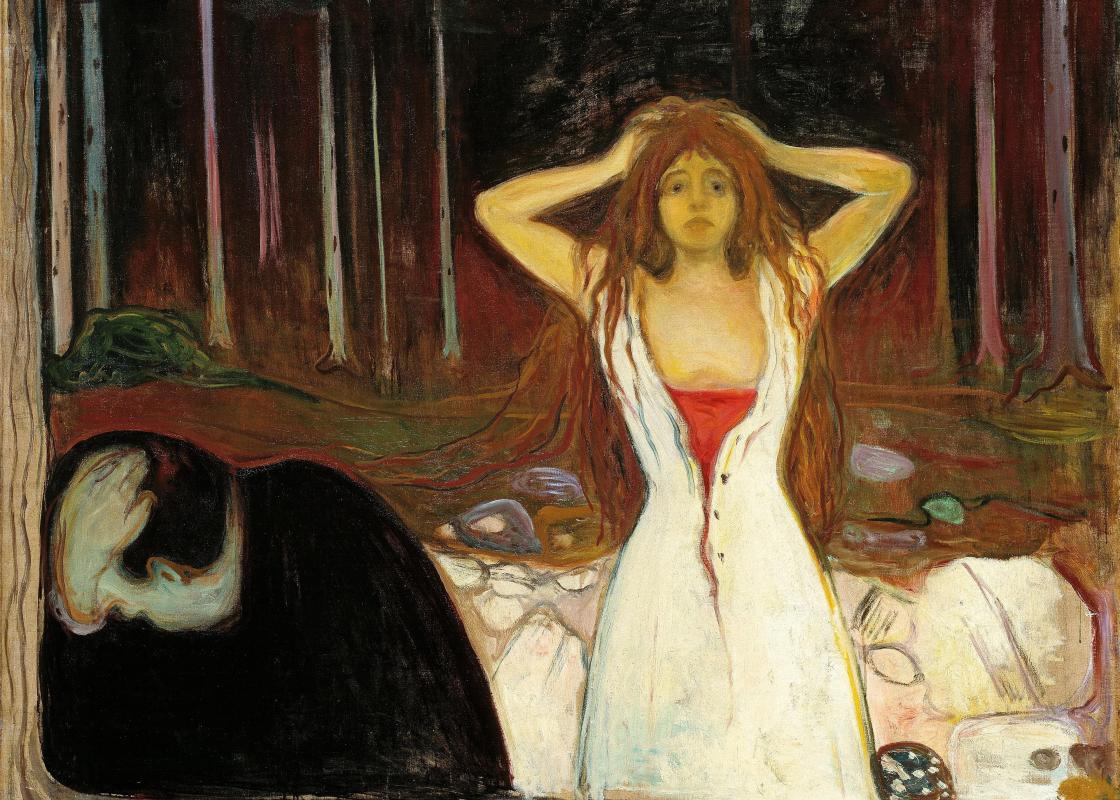“There is often something feminine and weak about beautiful men. Edvard Munch was beautiful. He was also fragile, but he did not seem weak.”
This is the opening of Rolf Stenersen’s biography Edvard Munch – portrait of a genius. The book became the object of research for Lars Toft-Eriksen, art historian and curator at the Munch Museum, when he began working on his PhD dissertation. He wanted to understand the biographer’s idea behind the term ‘artistic genius’.
“In contemporary art there is a lot of reflection around the role of the artist,” he explains.
“The idea of the artistic genius is often regarded as a cliché from Romanticism and Modernism. But it is still alive among the general population, and I was therefore confronted with this idea as a curator.”
Munch contributed to his own myth
Toft-Eriksen explains that there is still an almost mythical idea of artists such as Munch outside of the art community.
“I wanted to explore the myth of the artist, the way in which it is expressed in Stenersen’s representation of Munch. I wanted to find the cultural and ideological ideas behind the myth and the biography.”

“You write that Munch contributed to his own myth?”
“Definitely. Munch played on his own self-mythologising already in the 1890s. One may argue that he staged himself,” he says.
“Among other things, he left a number of notes and diaries that are clearly constructed. One can see that he has edited the descriptions of the same incidents several times, often years after they first happened, and made them fit into a larger narrative. He wanted to create an image for posterity.”
Toft-Eriksen emphasises that Munch had a close relation to Stenersen, and that he actively contributed to the creation of the image given of him in the in the biography.
“The biography is driven forth by anecdotes, not dry facts,” he explains.
“Anecdotes are unconfirmed stories that give the impression of being factual, and they therefore create a reality effect within the greater narrative. They play an important rhetorical role in Stenersen’s story, since they allow him to root complex ideals and ideas in concrete incidents from Munch’s life – whether true or false.”
A femininity reserved for men
The androgynous was particularly emphasised as an expression of genius in Modernism. Stenersen opens his Munch biography with a description of the artist’s appearance, in the following words: “He had a strangely well-built and graceful head. People turned to look at him in the streets, even before he obtained a name as an artist. A person who had seen Edvard Munch would never forget it.”
“He is described as stereotypically feminine. There is even a degree of physical passion in the author’s voice when it describes Munch,” Toft-Eriksen explains.
Simply put, creativity was regarded as a feminine quality, even though artistic activity was primarily reserved for men.
“At this time, the idea of the creative genius was closely connected to the androgynous. Simply put, creativity was regarded as a feminine quality, even though artistic activity was primarily reserved for men.”
Where brilliance in previous times was considered a gift from God, during Romanticism and Modernism the attention was directed toward the individual. According to Toft-Eriksen, this brought along a gender aspect.
“Brilliance is closely connected to the idea of the unconscious, and thus an irrational quality. One could not learn to become a genius, it came from within,” he explains.
“The ideal of the genius may be regarded as a counter-reaction to the focus on rationality during the Enlightenment. By considering brilliance as an expression of something unconscious, it was also considered a feminine quality. This perception was founded on the idea that men were rational and conscious, whereas women were irrational and to a greater extent governed by unconscious impulses.”
“In other words, there was an idea about the creative and brilliant as something feminine, but it was a femininity reserved for men.”
Contemporary perceptions of gender
These ideas spread widely among Munch’s radical social circle in Berlin. They discussed gender and sexual policy, and challenged the norms of their time.

“Munch was most probably aware of these currents. It is impossible to say for certain, but it is probable that he played on them, as a form of image building. At least Stenersen clearly
plays on the idea of an androgynous artistic figure in his descriptions. He idealised Munch in light of a stereotype.”
In Munch’s paintings, androgyny was expressed by way of an unstable masculinity, according to Toft-Eriksen.
“He clearly focused on weak male figures who were submissive to, or victims of, women. This has to be seen in light of the extremely complex views on gender at the time,” he says.
“On the one hand, you had a dawning feminist and sexual political awareness among parts of the Christiania bohemia, in addition to more radical currents in the social circles around Munch in Berlin. This obviously influenced Munch.”
Brilliance and madness
The idea of the androgynous artistic genius was also connected to the contemporary perception of madness. Freud’s psychoanalysis of Leonardo da Vinci played a central part in this,” Toft-Eriksen explains.
“Leonardo was considered ‘the ultimate genius’. His artistic style was perceived as feminine, and he was interpreted within an androgynous, sexually deviant context,” he says.
Ideas about brilliance and madness resembled one another in terms of being psychological deviations from what was considered normal
“According to Stenersen’s explanation, Munch had a ‘divided mind’. The ideals about brilliance and madness resembled one another in terms of being psychological deviations from what was considered normal.”
Thus, the madness also became part of the myth of the genius.
“Madness was of course viewed as something negative, but the result of the madness, the art, was considered intellectual excess,” he says.
“In some people’s opinion, it was disruptive for society, a sort of destructive brilliance. This was well received by the artists themselves, who used their madness as a badge of honour. You may say that Modernism cultivated madness.”
Munch’s genius explained in light of mother’s death
In Munch’s case, his mother’s death was used as a psychoanalytical explanation to his brilliance.
“You may regard Freud’s analysis of Leonardo as a model for Stenersen’s text. Freud considered creativity as a way of processing traumas from childhood. In Stenersen’s interpretation of Munch, this trauma was his mother’s death,” Toft-Eriksen explains.
“Munch’s art was influenced by the misogynous attitudes of his time. In his paintings, we see stereotyped female figures, often to the extremes. Stenersen explains this with the loss of his mother, and a subsequent fear of death. According to his biography, death, sexuality and reproduction were connected in Munch’s mind, which led to a fear of women.”
In line with Freud’s theories, Munch’s childhood trauma resulted in an asexual lifestyle.
“Munch treated his art works as his own children, as a sort of ticket to the future. Stenersen argued that his art overshadowed his sexual life.”
According to Toft-Eriksen, Stenersen’s psychoanalytical approach partly undermines the romantic idea about the artistic genius.
“Creativity and originality are important parts of the myth of the genius. The term originates from ideas about fertility, of the creation of life,” he explains.
“Stenersen’s representation of Munch as an asexual genius somehow punctures this myth. Munch’s creativity opposes the idea of originality in the sense that art is seen as forced repetition.”
An historical perspective
Ingeborg W. Owesen, philosopher, art historian and senior adviser in the Research Council of Norway, has worked with questions related to Munch and gender theories in the early twentieth century. In her opinion, the historical perspective is essential in order to understand an artist.r.

“Toft-Eriksen has placed Munch within a historical context by drawing attention to several theoretical perspectives from the artist’s own time. It is very interesting,” she says.
“In the biographical genre, an artist such as Munch easily becomes a heroic figure, but I find it more exiting when there is a certain distance. If you view him within the historical framework in which he lived, like Toft-Eriksen does, this opens for more perspectives.”
She explains that Munch lived during a historical period of transition.
“Different gender theories flourished. You had new currents such as the struggle for women’s right to vote and the Christiania bohemia’s ideas about sexual freedom. There were many different voices in Munch’s time that must have influenced him.”
Contributed to a change in the attitude towards women
According to Owesen, one cannot simply view Munch’s attitude to women based only on Stenersen’s biography about him.”
“Munch has a multifaceted oeuvre,” she says.
“He has created some of the most beautiful and painful images of female figures in art history, and he demonstrated a great understanding of his motives.”
According to Owesen, one may argue that Munch’s Madonna has had an effect on attitudes to female sexuality in Norway. She draws parallels to the way in which Ibsen’s play A Doll’s House influenced attitudes to women’s role in society.
“There are close ties between culture and politics, and Munch contributed to the development of a collective attitude directed towards increased gender equality, although he may not have been aware of this himself.”
At the same time, she points out that some of the paintings demonstrates Munch’s own insecurity.
“Sometimes he expresses something resembling love anxiety. Therefore, there is a sense of frustration connected to some of his female figures. On the other hand, he also created wonderful portraits of women from his own social circle. First and foremost, he demonstrates sensitivity and empathy with his motives, regardless of gender.”
Women not called genius
Munch’s attitude to women was influenced by the currents of his time. Women were to a greater extent than before regarded as subjects, and feminism was gaining foothold. Both of these issues challenged men’s dominant position.
“More generally, we see that women are not referred to as geniuses. That was a category reserved for men,” Lars Toft-Eriksen explains.
Women may be referred to as exceptional, but are rarely called geniuses.
“The category of genius became a gender political expression of power. Although the number of female artists was increasing, even before Munch’s time, women’s creativity was considered inferior to men’s. Thus female artists were suppressed at the same time as femininity was idealised.”
Even today, there are largely men who are considered geniuses. According to Ingeborg W. Owesen, we need to look at the idea of the genius also in light of external factors.
“Women are often referred to as unique or exceptional, but rarely as geniuses,” she explains.
“We may perhaps trace this back to Immanuel Kant’s idea of the genius, in which one of the preconditions was that you had to form school with followers in order to qualify as a genius. Munch had many followers who pursued the artistic schools or directions we refer to as Expressionism and Symbolism, and he thus qualifies according to Kant’s ‘requirement’. Few artists have followed a woman’s footsteps to a similar degree, however, and therefore, female artists also fall out of the canon.”
The idea of the artistic genius is still alive
“Brilliance is often considered an inner condition, a personal quality, but external factors should also be taken into consideration. Social conditions affect who are declared as genius.”
The debate that went on in the early 1900s has striking parallels to our time, says Toft Eriksen. He thinks that Stenersen’s biography illustrates this.
“Gender, gender expressions and gender identity are terms that are currently under a lot of debate. These are not new ideas, however, and the criticism is not new. The debate was very similar a century ago.”
When it comes to Modernism’s idea of the artistic genius, the curator argues that it is still alive and kicking today.
“Many artists today would laugh at this idea, but it is still alive among the general public. It is a narrative that people still wants to hear when they visit the Munch Museum, and I asked myself why. I do not think it has to do with Munch as a person in particular, but rather with his role as a manifestation of the myth.”
Translated by Cathinka Dahl Hambro.
Lars Toft-Eriksen defended his PhD thesis ‘Based on a True Story: Rereading Rolf Stenersen’s Image of Edvard Munch and the Myth of Genius’ on 26 August at Department of Philosophy, Classics, History of Art and Ideas, University of Oslo.
Toft-Eriksen is employed at the Munch Museum, and the PhD project was a collaboration between University of Oslo and the museum.
Edvard Munch (1863–1944) was one of Modernism’s most important artists. Munch was part of the artistic school referred to as Symbolism in the 1890s and later the expressionistic art from the beginning of the twentieth century onwards. His continued experimentation with painting, graphic arts, drawing, sculpture, photography and film has given him a unique position within Norwegian and international history of art.
Rolf Kristian Eckersberg Stenersen (1899–1978) was a businessman, author and art collector. He gathered a large collection of art, containing works by Edvard Munch among others, which are today part of the Stenersen Museum. He was a personal friend of, and adviser to Edvard Munch, and he also wrote a biography of him that was published in 1944: Portrait of a genius.



